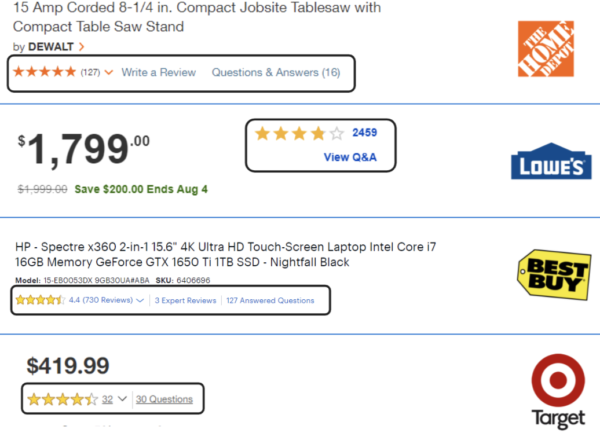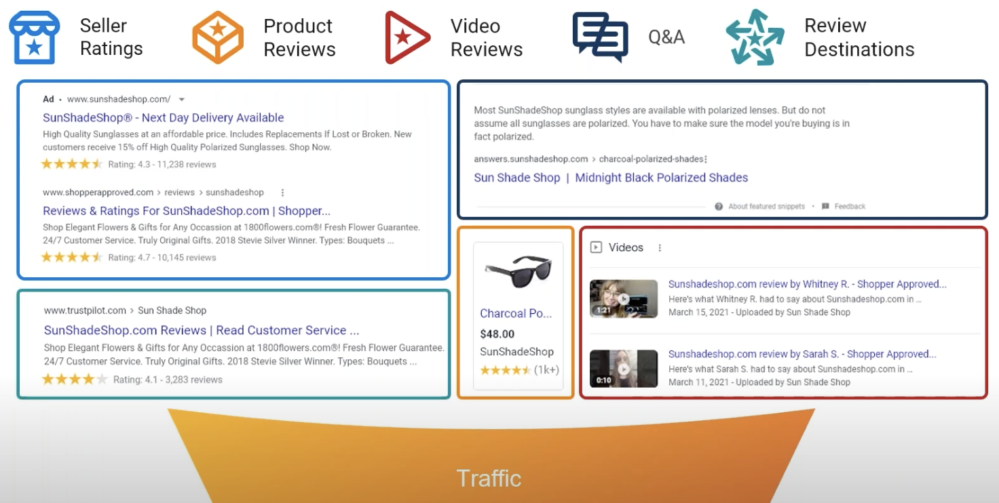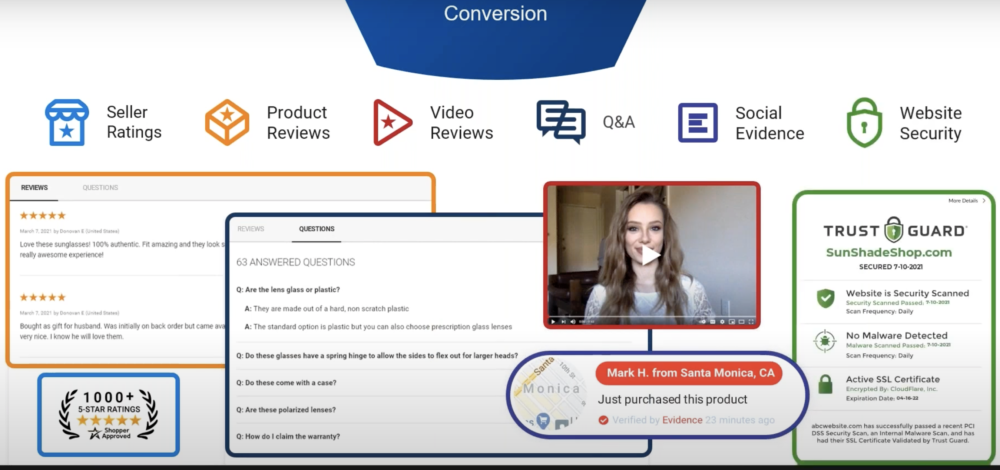Wishing your ecommerce site had more organic traffic and higher conversion rates?
Want to be a dominant player in your space?
On August 4, I moderated a sponsored Search Engine Journal webinar presented by DJ Sprague, CMO at Shopper Approved.
He shared tips on how ecommerce websites of all sizes can swipe Amazon’s top three traffic and conversion strategies.
Here’s a recap of the webinar presentation.

Amazon has strategically and intentionally placed ratings, reviews, and Q&A (what Shopper Approved calls the “Traffic and Conversion Stack”) immediately following the product name and description.

This means that this is the most important conversion content beyond the product name.
It’s not just Amazon that uses this proven strategy. Major online retailers such as The Home Depot, Lowe’s, Best Buy, and Target are doing the same.

The Elements That Make a Product Page Drive Trust & Conversions
According to Shopper Approved’s national independent survey, 88% of respondents are more likely to buy from a product page that shows ratings, reviews, and Q&A vs. a product page without it.

But how effective is the traffic and conversion stack at driving trust and conversions on a non-Amazon site?
In the same survey, they found that 91% were more likely to buy from a product page that displays ratings, reviews, and Q&A compared to a page that only has basic product info.

The findings also revealed that product ratings and reviews were influential in the buying decision:
- 68% said product reviews have a ‘high’ or ‘very high’ influence on their buying decisions.
- 69% said that they read reviews when searching for a product online most or all of the time.
For 94% of respondents, having a Q&A section on a product page when researching a product to buy was moderately to extremely important for them.
They are also more likely to buy if a product page has a Q&A section that answers their product questions.
Additionally, 83% of respondents consider secure transaction signals as very or extremely important when buying online.
A ‘Secure Transaction’ link next to the ‘Buy Now’ button increases the chances of consumers buying a product.
Having optimized Q&A content also gives you an edge over your competitors in search results.
At least 73% of respondents will highly or extremely likely visit a website that answers their product question and came up at the top of the Google search results.
Showing up at the top of Google search results increases the perceived credibility of that website.
E-A-T in Ecommerce
Aside from the survey results, Shopper Approved dug deeper and looked at how the concept of the traffic and conversion stack aligned to Google’s Search Quality Evaluator Guidelines which are used by human website rankers to rate websites based on quality.
According to the document:
“Reputation research is necessary for all websites you encounter. Use reputation research to find out what real users think about a website. Look for reviews…
We consider a large number of positive user reviews as evidence of a positive reputation.
When interpreting customer reviews, try to find as many as possible.”
You should also invest in security to boost your website’s trustworthiness.
Both Google and shoppers have these three critical trust questions in mind:
- Can I trust this seller?
- Can I trust this product?
- Is this a secure site?
If the shopper can’t confidently answer all three of these questions in the affirmative, they aren’t going to convert.
So you want to make sure you’re continuously addressing these areas.
How to Create a Traffic & Conversion Stack for Your Ecommerce Site
So how can you swipe Amazon’s traffic and conversion stack to make it work for your own site?
With Shopper Approved’s solution, you’ll be able to automate the process so you can generate content at scale.
To boost your organic traffic, you can leverage:
- Seller ratings.
- Product reviews.
- Video reviews.
- Product Q&A.
All this content populates the organic and paid search results, your Google Shopping product listing ads, video results, and even third-party open review platforms with your ratings reviews so you have a good score across the web.
This also gives you a lot of good visibility and SEO value, along with “pre-conversion trust” – helping you become seen as an authoritative resource and increasing the likelihood of searchers clicking on your website.

Next, it’s important to optimize for page experience to drive more conversions.
On your product pages, make sure to incorporate:
- Seller ratings.
- Product reviews.
- Video reviews.
- Product Q&A.
- Social evidence.
- Website security.

Once you bring all these elements together on your product pages, you’ve essentially mitigated all of the friction points that people have about buying or converting on your site because you’ve addressed all your concerns through helpful and relevant content.
Key Takeaways
- Amazon has proven the “Traffic and Conversion Stack” is best practice. 91% of consumers surveyed verified this finding.
- When applied, this strategy can increase organic traffic 4x and conversion rate 9x.
- Shopper Approved is the only company that offers it.
Want to learn more about the Traffic and Conversion Stack?
Get a free ebook, along with a case study and the research results here.
Q&A
Here are just some of the attendee questions answered by Sprague.
Q: Can I use the traffic and conversion stack on any ecommerce site?
DJ Sprague (DS): Yes you can. Any website that sells products, services, or information needs Google Seller ratings, Product Reviews, Q&A, and a secure payment seal.
Q: Does Shopper Approved help with the installation?
DS: Yes, our onboarding team helps with all the set-up
Q: How can I improve the SEO value of Q&A?
DS: Use Ahrefs to find the keywords and search terms that are driving traffic to your site, and your competitors, and use Q&A answers to answer those questions.
Look at the Q&A and FAQ on your competitors’ websites, and answer those questions in your Q&A, product descriptions and product details, because our Q&A tool will pull info from those resources into the answer as well, giving you multiple exposure and SEO opportunities.
Look at the Q&A of the same or competitive products on Amazon to answer those questions in your Q&A.
Q: How can a new site get the largest amount of reviews in the shortest amount of time?
DS: You also want to optimize your engagement and conversions, because conversions lead to reviews.
That’s why it’s important to have things like Q&A on your page. Because, even if you don’t have any reviews for a product yet, it gives the visitor a light way to engage your brand.
When you answer with a quality response, that builds the necessary trust to convert the sale which then allows you to get those reviews flowing.
Q: How to get Q&A content for a new site that doesn’t have much traffic?
DJ: If you’re a new site, you should still have Q&A on your product pages so you can get the visitors that you do have engaged and moving toward a sale.
But, if you want to ramp up your organic traffic as those questions start to flow, you can also seed content in bulk in order to jump start things.
We have seen experiences where customers have invested into some great Q&A content to start, some have imported up to 1K Q&A threads and imported at their launch.
That content turned into over 300K organic visitors to that content over the first year after publishing it. It’s all about making sure that you’re publishing quality content that people are looking for.
Every site may not want to invest in creating that much content as the example I just mentioned…but you can choose how much you can invest in resources and then import that.
You can see what questions have been asked about similar products on Amazon and other sites, and then make sure that you’re answering those questions more effectively to ensure your content will compete and start to match those long tail searches.
Q: Does Amazon have a landing page for each product question & answer thread?
DS: You’ll see that when you’re on the Amazon product page and go to the product Q&A section, that each of the question titles is actually a link and if you click on that link, it goes to a landing page dedicated to that Q&A thread.
So, they at least do this for the product Q&A that they’re displaying on the page, and you’ll see those landing pages coming up in SERPs (as shown in our examples).
We don’t know whether they do this for all of their Q&A content or whether it’s just select queries.
There are ways to optimize the Q&A content so you have those landing pages spawn in a smart way and perhaps not for every thread.
For example, with our Shopper Approved Q&A solution, you can choose to have Q&A threads that are over X words, launch their own landing pages, and then identify “Short Answers” that will be published as a series of Q&A threads related to the same product on the same page.
You can take thinner Q&A threads and have them work together to build more robust pages of content.
Q: How does product questions and answers increase conversions?
DS: When a customer engages you to ask a question about the product, they are in the last steps of their journey to purchase their product and are just looking for some final confirmation to ensure the product is a fit for their needs.
When you provide an answer that confirms that it does satisfy their needs, we’ve seen that our customers will see a conversion up to 75% of the time.
If you’re Q&A tool is managing things effectively, it will answer their question without the user needing to wait (or you having to spend any additional time) through suggesting answers from the Q&A content if the question has already been asked before and suggesting answers the information is already covered within your product descriptions and specifications.
This allows the user to get the fastest response to their questions and get on with the sale. Of course, for brand new questions, your team is notified immediately and you can effectively answer that new question to convert the sale.
That new Q&A content works not only to convert that customer, but also goes to work for you from that date forward as it will automatically answer that same question if future visitors ask a similar question on your product page.
It will also start to show in SERPs for customers who are asking similar questions through Google.
We’ve seen that traffic further grow conversions and actually see that the average lifetime value of those customers is up to 2x higher than a merchant’s normal Google traffic.
Q: Can Q&A be used to optimize SEO on product category pages?
DS: Yes. We’ve seen that for some merchants they are looking to mature and optimize the original content on their product category pages….sometimes it’s even a higher focus than they have on their product pages.
In these cases, you can put a Q&A call to action and content within your product category pages and get the questions that are asked if a visitor doesn’t quite know what product will fit their need.
The answers to those questions can then lead them to the product (or group of products) that will best suit their needs.
For example, we have customers where we sync their Shopper Approved Q&A account with their Shopify Collections (and other platforms as well) and then they put the Q&A engagement under their product category results table to spawn that engagement and content.
Q: Is it best to have other customers be able to answer product questions as well?
DS: This answer depends on your business preferences and you can get great results from your Q&A content either way.
At the end of the day, Google is looking to ensure that they give the best possible answer to each search query so if your company is going to provide great content you should be able to see great results from that content.
There are advantages to having the community of customers give their own answers as well through social proof and structured data.
When a customer asks a question on your site, if they see the answer is given from a verified purchaser who doesn’t work for the company that is selling them the product, there is a layer of trust there and social proof that is gained.
Also, for your Q&A landing pages, if you’re using a more robust product Q&A capability like Shopper Approved Q&A there is a specific schema that you can apply if you’re supporting community answers where you can have the markup of that page contain structured data that adheres to the QAPage schema which makes you eligible for Google’s Q&A rich results.
We would note that if you’re going to consider community answers, you’ll just want to recognize that it will add some moderation and review work to ensure the responses are valuable.
There are tools that our solution has built in to control profanity, spam, etc., but there will always be an element of review and moderation when it comes to community answers that you’ll just want to account for.
[Slides] Drive Traffic and Conversions: 3 Secrets Amazon Doesn’t Want You To Know
Check out the SlideShare below.
Join Us For Our Next Webinar!
The CMO’s Guide To Winning In AI Search With Ahrefs
Join us for a strategy session and demonstration from Ahrefs designed to help you lead with future-proof visibility.
Image Credits
All screenshots taken by author, August 2021


